Mastering Bathroom Drywall Waterproofing Techniques
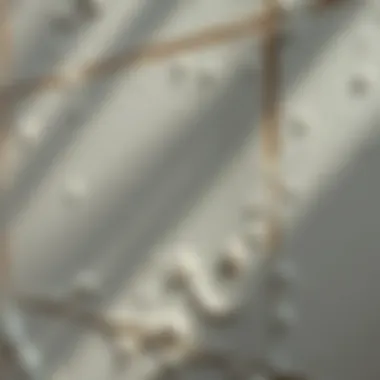
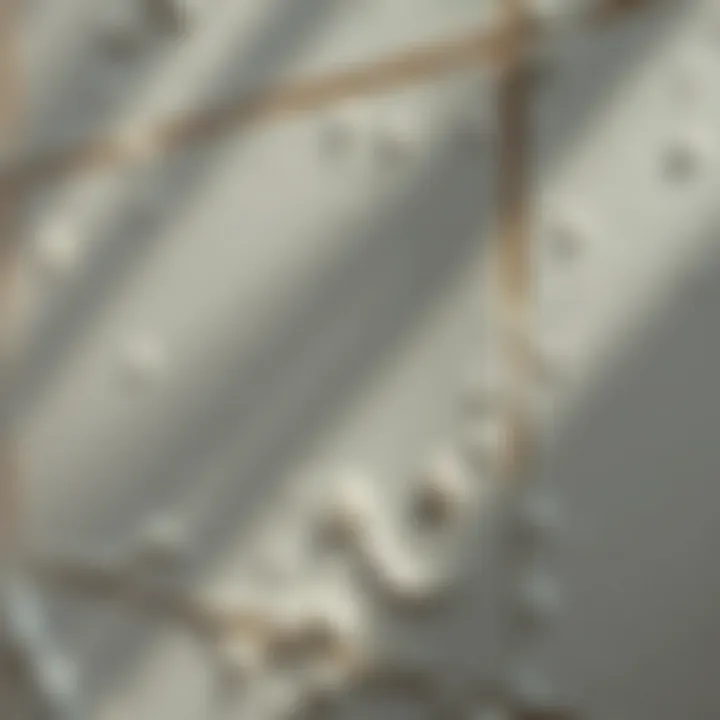
Intro
When it comes to remodeling a bathroom, waterproofing drywall should be at the top of your to-do list. Bathrooms are notorious for soaking up moisture, which can lead to all sorts of problems, from mold growth to structural damage. A proper waterproofing job acts as a solid preventive measure, saving you from costly repairs later on. So, let's roll up our sleeves and get down to business.
The Importance of Waterproofing for Bathrooms
Waterproofing drywall in bathrooms isn't merely a construction consideration; it’s a necessity that can save money, hassle, and a great deal of stress down the line. Bathrooms naturally accumulate moisture due to daily activities like showers and baths. If these areas aren't effectively waterproofed, it can lead to a cascade of problems that could affect not just the bathroom, but the entire house.
Homeowners must recognize that neglecting to properly waterproof a bathroom may yield costly consequences later. When moisture seeps in, it can cause damage not only to the walls but also to the flooring, cabinetry, and even the structural integrity of the home. Furthermore, excess moisture fosters mold and mildew growth, which can compromise air quality and pose health risks to residents.
Effective waterproofing ensures that bathrooms remain dry and comfortable spaces, free from the worry of leaks and dampness. It also contributes to the longevity of materials used in the space, making it a worthy investment for any homeowner. This investment maintains aesthetic appeal and prevents unsightly stains and decay, fostering an environment that is healthier and more pleasant.
Understanding Moisture Risks
Bathrooms are a prime habitat for moisture accumulation, presenting various risks that homeowners may sometimes overlook. Regular activities such as showering produce steam, while water spills can lead to pooled moisture. Additionally, poor ventilation amplifies these problems, allowing humidity levels to rise and wreak havoc on drywall and other materials.
Let’s consider a few common moisture risks:
- Condensation: When warm air from showers meets cooler surfaces, it can lead to condensation buildup, which can trickle down into materials unprotected.
- Water Leaks: Tiny leaks from pipes or fittings can create an environment for mold if they go unnoticed. Regular inspections around faucets and toilets are critical.
- Humidity: Without proper ventilation systems, the bathroom can become a swamp, raising the risk of structural damage to drywall.
This is why understanding the moisture profile in your bathroom is crucial. By knowing where the moisture is coming from, you can take proactive measures to seal off these risks effectively.
Consequences of Poor Waterproofing
Lack of proper waterproofing can lead to significant setbacks for homeowners. Let’s unpack some of the implications of ignoring this essential task:
- Mold and Mildew Growth: One of the most serious risks is the development of mold and mildew, which can be harmful to health and more troublesome to eliminate once it has taken root.
- Structural Damage: Unaddressed leaks can cause walls to warp or become soft, necessitating costly repairs. Swollen drywall is often a tell-tale sign that the underlying structures aren't secure.
- Increased Repair Costs: Regular maintenance becomes compromised when waterproofing isn't adequately addressed. Homeowners may find themselves in a cycle of short-term fixes rather than investing in comprehensive solutions.
- Reduced Home Value: Long-term water damage can drastically decrease a property's value. Potential buyers are usually wary of homes with a history of moisture problems, impacting resale value.
The long and short of it is clear: investing in waterproofing isn't just a precaution but an integral part of maintaining a safe, healthy, and value-retaining home. Avoiding the pitfalls associated with poor waterproofing ultimately makes life easier and ensures lasting satisfaction.
Types of Drywall Suitable for Bathrooms
In the realm of home renovation, choosing the right drywall is paramount, especially in moisture-prone areas like bathrooms. The two primary contenders that often come to mind are green board and cement board. Investing in the correct type can save homeowners from the pervasive headaches associated with water damage, mold growth, and structural issues down the line. By understanding the characteristics of each, one can make informed decisions tailored to their specific situations.
Green Board: A Common Choice
Green board, often what folks think of when considering drywalls in bathrooms, is a moisture-resistant material. Its green paper facing helps distinguish it from regular drywall, suggesting that it's better suited for damp environments. When deciding whether to go for green board, one should consider its advantages:
- Moisture Resistance: This drywall can handle the humidity of bathrooms far better than standard drywall, providing a layer of protection against mold and mildew formation.
- Ease of Installation: It's lightweight, making it easier to manipulate during installation, which can be a blessing for DIY enthusiasts.
- Cost-Effective: While not the cheapest option available, green board usually offers a good balance between performance and price, fitting well within most renovation budgets.
However, it’s crucial to understand that while green board has its virtues, it is not entirely waterproof. It’s best used in areas with low to moderate moisture exposure, such as walls not directly exposed to shower water. Some might say it’s more like a band-aid than a cure when discussing high-moisture zones.
Cement Board: A Durable Alternative
On the other hand, when looking for a more heavy-duty solution, cement board struts its stuff impressively. Made from cement and reinforcing fibers, it’s the heavyweight champion for areas that take a constant drenching. Here's why cement board is worth considering:
- Superior Moisture Protection: Unlike its green counterpart, cement board stands up to direct water exposure. Because it’s not made from organic materials, it won’t warp or swell over time, making it an ideal choice behind tiles or in high-humidity regions.
- Enhanced Durability: This material is tough as nails. Whether it's a busy household or a steamy, relaxing atmosphere, cement board can take a pounding and still emerge unscathed.
- Versatile Applications: Besides bathrooms, it’s perfect for kitchens and even outdoor settings where exposure to moisture is significant. Homeowners often find it ideal for shower installations as it resists mold and mildew growth efficiently,
Given these factors, cement board might come with a heftier price tag and can be more labor-intensive during installation. But the long-term benefits often make it a worthwhile investment, and for those who want peace of mind about their renovations, it’s like putting money where you know it’s safe.
"Choosing the right type of drywall in bathrooms isn't just about aesthetics; it's about creating a long-lasting defense against moisture and mold."
Understanding the strengths and weaknesses of both green board and cement board provides homeowners with the knowledge needed to create a robust and moisture-resistant environment. By weighing these options carefully, one can design a bathroom that balances beauty with functionality.
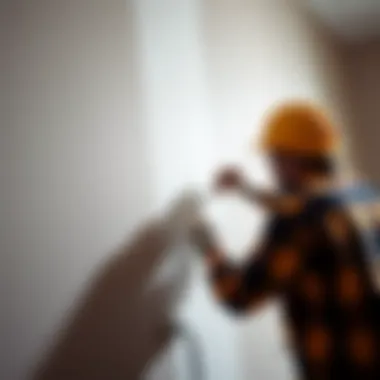
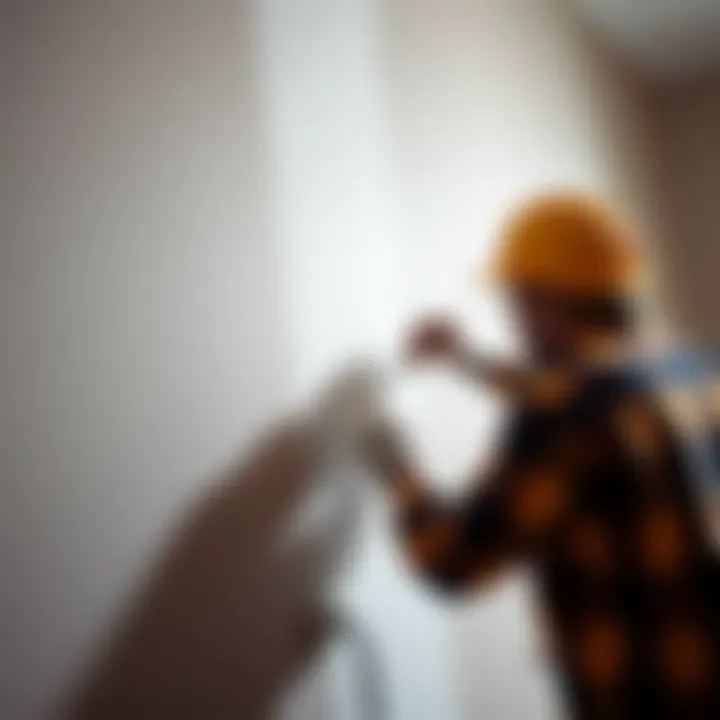
Essential Waterproofing Materials
When it comes to safeguarding your bathroom against moisture infiltration, choosing the right waterproofing materials is crucial. The bathroom, being a high-moisture environment, demands robust solutions that stand up to the perennial onslaught of water. Understanding essential waterproofing materials can save homeowners headaches down the line. These materials not only protect the drywall but also contribute to the durability and longevity of the entire bathroom structure.
Key elements to consider in waterproofing materials include their ability to repel water, ease of application, and suitability for specific areas—like behind tiles or around fixtures. It's vital to think about not just the initial installation but also how these materials perform through the wear-and-tear of daily use. Choosing wisely ensures that your efforts in waterproofing will pay off, keeping that freshly remodeled bathroom looking sharp and functional for years to come.
Waterproofing Membranes
Waterproofing membranes serve as a frontline defense against moisture. They create a seamless barrier that prevents water from penetrating the drywall, thus preserving the integrity of the structure. Typically made from thin sheets of plastic, rubber, or asphalt, these membranes can either be applied in liquid form, which then hardens, or installed as pre-formed sheets.
Types of Waterproofing Membranes
- Sheet Membranes: These are laid out and sealed at seams to cover large areas like walls and floors. Think of them like a raincoat for your bathroom.
- Liquid Membranes: When you need flexibility, liquid options are ideal. You can apply them with a brush or roller, ensuring coverage around tricky spots like corners and plumbing.
Benefits of Waterproofing Membranes
- Seamless Protection: Membranes can cover joints and seams, which are often weak points in waterproofing.
- Flexibility: Liquid membranes can adapt as the building settles or shifts.
In using waterproofing membranes, preparation is key. The surface must be clean and free from any debris that might hinder adhesion. A good practice is to also check the manufacturer's instructions for specific climate considerations.
Preparation for Waterproofing Drywall
Preparing for waterproofing drywall in bathrooms is a crucial step that can make or break your project. This phase isn't just about getting your materials ready; it requires a careful evaluation of the surfaces that will be treated. Failing to prepare adequately can lead to all sorts of headaches down the road, like mold growth or peeling paint. So let's dive into what you need to do to get it right.
Assessing Existing Conditions
Before you start your waterproofing journey, it's vital to take stock of the existing conditions in your bathroom. This includes examining the walls for any signs of previous water damage or current moisture issues. Check for peeling paint, discoloration, or soft spots in the drywall, as these may indicate underlying water problems.
You’ll also want to assess the overall structure of the drywall itself. If the drywall is old and lacks integrity, replacing it before waterproofing might be a wiser move. It’s like going for a health check-up; knowing what you're working with helps in making informed decisions.
Considerations:
- Look for mold: This can spread quickly if not dealt with, so addressing it should be a top priority.
- Check for cracks or gaps: These can let moisture in, making your waterproofing effort futile.
- Assess the ventilation: Good airflow can significantly reduce moisture problems, which might influence your waterproofing choices.
By taking the time to assess existing conditions, you’re setting a strong foundation — literally and figuratively — for effective waterproofing.
Cleaning and Repairing Surfaces
Once you’ve assessed the conditions, the next step is cleaning and repairing surfaces. A pristine surface is essential for the materials to adhere properly. Any debris, dust, or grease leftover will reduce the effectiveness of your waterproofing measures. It’s all about that clean slate!
Begin by cleaning the drywall with a mild detergent solution to remove any dirt or oils. A simple sponge and bucket combo will do. After cleaning, ensure everything is dried thoroughly to avoid trapping moisture. Once the walls are clean, take a moment to repair any damage you identified during your assessment.
Key Repairs:
- Patch any holes: Use appropriate drywall compound to fill in any gaps and ensure a smooth finish.
- Seal any cracks: A good caulk can work wonders here, preventing moisture from sneaking in.
- Address surface mold: If there's any stubborn mold, use a mold-resistant solution to treat the area, making sure it's completely dried afterwards.
Failing to clean and repair can compromise the waterproofing efforts, leaving your bathroom vulnerable to moisture damage. Prepare like you mean it.
Preparation is the key to success.
With a solid groundwork laid out through assessment and surface preparation, you’ll be much closer to achieving a dry and durable bathroom. Following these steps not only boosts the chances of your waterproofing efforts holding up over time but also enhances the overall look and feel of your space. Homeowners can enjoy long-lasting results when they take preparation seriously, so roll up those sleeves and get to work!
Application Techniques for Waterproofing
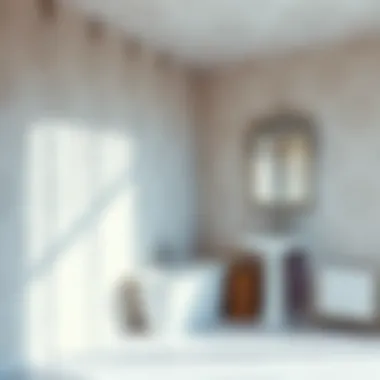

When it comes to ensuring that your bathroom remains dry and free from mold, understanding the doğru application techniques for waterproofing drywall is key. This section dives into essential methods of installation that help to create a barrier against moisture. With the proper application, you not only prolong the life of your drywall but also safeguard your home’s structure. Utilizing the right techniques can provide many benefits, such as increased durability, reduced repair costs, and enhanced overall safety in your bathroom.
Using Waterproofing Membranes
Waterproofing membranes are valuable tools in the battle against moisture. They act as a protective layer that prevents water from penetrating into drywall, which can lead to extensive damage if left unchecked. Here, we will discuss three main aspects of using waterproofing membranes: preparation and cutting, applying adhesive, and sealing edges.
Preparation and Cutting
Getting your membrane prepared and cut correctly lays the groundwork for successful installation. Ensuring the size and shape match the area accurately is crucial, as improper cuts can leave gaps that invite water in. The precision in preparation and cutting not only facilitates a smooth application but also prevents costly mistakes down the line. A unique feature of this process is that a good fit increases the effectiveness of the waterproofing, which is a key characteristic of membranes. On the downside, if you rush the cutting phase, you might end up with uneven edges or irregular sizes that complicate the application.
Applying Adhesive
Once your membrane is cut correctly, it’s time to apply the adhesive. This step is critical because it ensures the membrane sticks securely to the drywall. Using the right adhesive is paramount—it needs to be strong enough to hold against moisture. This application is popular among homeowners as it provides a reliable bond that lasts. A unique feature here is that the adhesive also helps in accommodating minor movements of the building materials. However, there is a flip side; if the adhesive is poorly applied, it could lead to peeling or detachment over time, potentially compromising the waterproof effect.
Sealing Edges
The final step in using waterproofing membranes is sealing the edges. It’s not enough to just lay down a membrane; the edges need to be secure to prevent any water intrusion. The sealing process is critical, as it fortifies the entire waterproofing system. Properly sealed edges can make your installation much more reliable, which is why many experts emphasize its importance. It’s unique in that it often acts as a line of defense against both water and mold. However, care should be taken; improper sealing can lead to trapped moisture, defeating the purpose of the waterproofing altogether.
Applying Liquid Waterproofing
Liquid waterproofing presents another method that can readily achieve a moisture-resistant surface. This technique is increasingly popular among homeowners due to its versatility and ease of application. Let’s dissect the essential components of this method by looking at the tools required, layering technique, and drying time.
Tools Required
To apply liquid waterproofing, specific tools are essential. Commonly needed tools are brushes, rollers, or sprayers, which allow for even application across the surface. These tools are beneficial because they enable smooth and uniform coverage, making them a favorite among DIYers. One unique feature is the sprayer, which can speed up the process, especially for larger areas. However, without the right tools, you may find the application uneven, which can lead to patches where moisture might seep through.
Layering Technique
A unique aspect of applying liquid waterproofing is the layering technique. Multiple coats help create a robust defense against moisture infiltration. Adding layers can significantly enhance the waterproofing effectiveness. This is popular due to the increased durability it offers; the thicker the application, the more protection you have. On the downside, improper layering can result in the formation of air bubbles or important fissures, which might allow moisture to sneak in.
Drying Time
Understanding the drying time of your liquid waterproofing is equally essential. Different products have varied drying times, which can influence your project timeline. It’s vital to let each layer dry thoroughly before adding the next. This aspect is particularly beneficial because proper drying ensures that the waterproofing forms a solid bond with the surface. The unique feature here is that faster-drying products allow you to complete projects more quickly, yet if not monitored, they might not adhere correctly, leading to issues later on.
Remember, patience is key when it comes to waterproofing. The time spent ensuring correct application can save countless hours and dollars in repairs later.
Best Practices in Waterproofing
When venturing into the intricate world of waterproofing bathroom drywall, adhering to best practices is paramount. This isn’t just about slapping on a coat of paint. It’s about creating an effective barrier that can stand the test of time against moisture and humidity. This section delves into pivotal elements that every homeowner ought to consider, ensuring a robust defense against potential water damage.
Importance of Best Practices:
A well-executed waterproofing job not only safeguards the drywall but also contributes to the overall health of the bathroom environment. Here are a few key aspects to keep in mind:
- Durability: An effective waterproofing strategy enhances the lifespan of your drywall and associated fixtures, saving money over the long haul.
- Health: Preventing mold and mildew growth fosters a healthier space for your family, keeping air quality in check.
- Aesthetic Appeal: Proper waterproofing means less damage and fewer repairs, maintaining your bathroom’s visual allure.
By adopting these practices, homeowners can navigate the challenges of bathroom upkeep more efficiently.
Ensuring Proper Ventilation
A fundamental yet often overlooked aspect of waterproofing is the role of ventilation. Bathrooms are notorious for high humidity levels, especially during showers and baths. Without adequate airflow, moisture can linger, compromising even the best-installed waterproofing systems.
Consider these ventilation strategies:
- Install Exhaust Fans: A good quality exhaust fan can significantly reduce humidity levels. Make sure it's rated to handle the size of your bathroom for maximum efficiency.
- Open Windows: If feasible, let nature do some of the work. Open windows provide natural airflow that helps reduce moisture buildup.
- Use Dehumidifiers: In particularly damp climates, investing in a dehumidifier can offer an extra layer of protection.
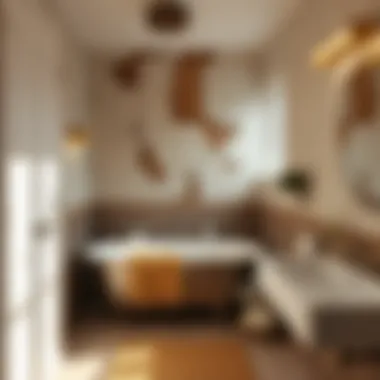
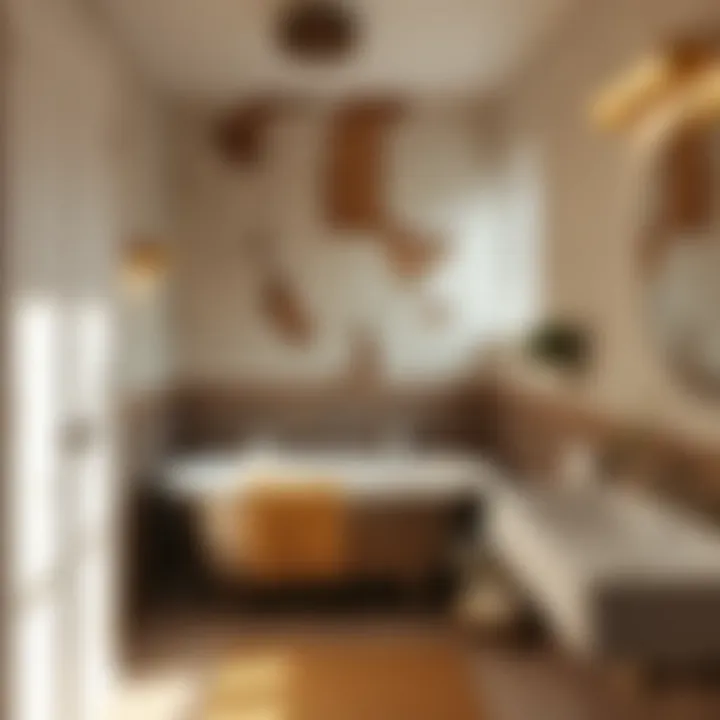
"Proper ventilation is the unsung hero in the battle against bathroom moisture. It’s a simple fix that yields big results."
By ensuring proper ventilation, you're not just waterproofing; you're enhancing your bathroom’s resilience against moisture.
Regular Maintenance Checks
Even with thorough waterproofing, nothing can replace the importance of regularly checking your bathroom’s condition. Just like maintaining a garden, keeping an eye on moisture-prone areas will lead to a healthier, more enjoyable space.
Here are essential components to focus on during maintenance checks:
- Inspect Grout and Caulking: Over time, these seals can wear out. Look for cracks or gaps and replace them if necessary.
- Check for Leaks: Regularly inspect under sinks and behind fixtures. A small leak can develop into a bigger issue if ignored.
- Monitor Ventilation Systems: Ensure your exhaust fans and vents remain unobstructed and functional. Clean filters if needed.
- Evaluate Paint Condition: Water-resistant paint can lose its potency. Consider refreshing it every few years to maintain effectiveness.
Incorporating these practices into your routine will help nip potential damage in the bud, ensuring your bathroom remains a sanctuary rather than a source of stress.
Troubleshooting Common Issues
Troubleshooting common issues related to waterproofing drywall in bathrooms is crucial for maintaining the integrity and safety of your home. Moisture can breed not just physical damage but also potential health hazards like mold and mildew. Close attention to detail, especially when you're doing repairs or renovations, can save you time and money down the line. Identifying problems before they escalate is key—after all, an ounce of prevention is worth a pound of cure.
Identifying Signs of Water Damage
Recognizing the early signs of water damage can mean the difference between a simple fix and a costly renovation project. Water can sneak in through the smallest cracks, making vigilance essential.
Some common signs to look out for include:
- Discoloration on Walls: This could appear as yellow or brown stains, often suggesting that moisture is trapped behind the drywall.
- Warped or Bubbling Drywall: If the drywall feels soft to the touch or appears to be bulging, this could indicate a serious moisture issue.
- Persistent Musty Odor: A damp smell can be a precursor to mold growth, signaling that water is present in areas it shouldn't be.
- Soft or Crumbling Drywall: As drywall becomes saturated, it loses its structural integrity and may begin to crumble or get mushy.
- Visible Mold Growth: Mold can form quickly in wet areas; check for black spots or fuzzy growth on surfaces.
Promptly identifying these signs can help you stave off more serious damage. Regularly inspect your bathroom, especially after heavy rainfall or flooding.
Repairing Damaged Drywall
Once you've identified water damage, acting fast can limit further deterioration. Repairing damaged drywall involves a series of careful steps to ensure that the area is restored effectively.
- Remove Damaged Sections: Carefully cut away the affected areas using a utility knife. Remove any drywall that is excessively warped or has visible mold to prevent the issue from returning.
- Allow to Dry: It’s vital to let the exposed area dry thoroughly before making any repairs. Good air circulation can aid this process—think about using fans or dehumidifiers.
- Treat for Mold: If mold is present, consider using a mixture of water and vinegar or a commercial mold remover to clean the surface. Ensure you wear protective gear to avoid inhaling spores.
- Replace Drywall: Cut a new piece of drywall to fit the opening you created. Secure it in place with screws or adhesive, ensuring a snug fit.
- Seal and Paint: After replacing the drywall, it’s essential to use a good-quality primer followed by a moisture-resistant paint to help deter future issues.
- Revisit Your Waterproofing: After repairs, reassess your waterproofing measures. Make sure seals and membranes are intact for ongoing protection against moisture.
Remember, it’s often easier to prevent water damage than to deal with the consequences later. Don't make haste; a well-done job saves you effort in the long run.
Retention of effective waterproofing practices will not only keep your bathroom pristine but also contribute to the overall comfort and safety of your home. Proper maintenance checks can go a long way in upholding the integrity of your living space.
Culmination: Importance of Vigilance
In the realm of bathroom renovations and constructions, the need for constant vigilance cannot be overstated. Many homeowners mistakenly view waterproofing as merely a one-time task. However, maintaining a robust waterproofing system is an ongoing commitment. Diligence in monitoring seals, membranes, and overall drywall condition fosters a peaceful living environment and saves you from costly repairs down the road.
Continuing to observe your bathroom’s state can yield insights into minor issues before they escalate. For instance, a small crack in the sealant can lead to water leaks, resulting in hidden mold or wood rot if not addressed promptly. Likewise, a steady increase in humidity might signify compromised waterproofing.
"An ounce of prevention is worth a pound of cure."
Taking proactive measures significantly enhances durability and ensures that the bathroom remains a sanctuary rather than a site of stress.
Long-term Benefits of Proper Waterproofing
Proper waterproofing is not just a precaution; it's an investment in your home. The immediate benefit is protection against water damage, but the long-term implications are much broader. Here are several advantages that come with investing time and resources in this essential task:
- Increased Property Value: A well-maintained space with proper waterproofing will always be more appealing to potential buyers. It shows that the homeowner cares about upkeep, making your property more attractive on the market.
- Reduced Maintenance Costs: Regular attention to waterproofing physical systems can help you avoid more significant, pricier repairs. Addressing minor leaks or moisture issues early can save you thousands in eventual mold remediation and drywall replacement.
- Enhanced Indoor Air Quality: Waterproofing helps prevent mold growth. Good air quality is crucial for the health of all inhabitants, especially those with allergies or respiratory issues.
- Peace of Mind: Knowing that you've taken the right steps to protect your space can reduce anxiety. You can confidently enjoy your bathroom as a haven of relaxation, free from the nagging worry of potential water issues.
Final Thoughts on Bathroom Drywall Care
Ultimately, the care you give your bathroom’s drywall is a reflection of the overall stewardship of your home. Each project, no matter how small, requires attention and care. Take time to regularly check the waterproofing, addressing issues as they arise rather than letting them build up.
It's wise to consult with professionals during significant renovations. Their expertise can guide you toward the best practices and materials suited for your specific needs. Also, keeping abreast of the latest trends can help you maintain an up-to-date space, which contributes to better waterproofing.
Overall, bathroom drywall waterproofing is not a solitary act but a holistic approach. Connect all elements: choose the right materials, apply them correctly, and maintain vigilance. In doing so, you create a resilient buffer against moisture, ensuring that your bathroom remains dry, healthy, and beautiful for years to come.







